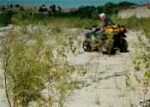Work day assaults invading salt cedar

TRENTON -- Salt cedar is like a sloppy house guest -- raiding the fridge, leaving messes all over the place and discouraging stays by visitors of a more desirable nature.
Salt cedar is a tree, or a bush, that is so invasive the Nebraska Department of Agriculture has added it to its "watch list" of potential noxious weeds, to help stop its sly spread northward.
Hitchcock County Weed Superintendent Rick Hedke hosted a first-of-its-kind "salt cedar workday" Aug. 14 at Swanson Lake west of Trenton, to help increase awareness of this "weed tree," and its impact on the environment.

The day was co-hosted by BASF, makers of the chemical used to spray the spreading mat of salt cedar along the shores of Swanson Lake.
Doug Haller of Kansas City, vegetation specialist for BASF, told weed specialists at the workday that salt cedar, or tamarisk, is a huge problem in the desert southwest of the United States, and is spreading along waterways throughout the Midwest and into Wyoming and Montana. "One salt cedar plant can suck 200 gallons of water a day," Haller said, "dropping groundwater levels and impacting surface water flows." Large stands of the plants can dry up lakes and suck streams dry, he said.
Any nearby vegetation, no matter how desirable, is impacted by the salt cedar's moisture-robbing habits, and soon, all but the salt cedar dies off.

Dan Beran of Des Moines, a technical specialist with BASF, said salt cedar collects salt in its needles, which kill any undergrowth when they fall. "Soon, we have a monoculture of salt cedar, and little or no vegetation underneath," Beran said.
The plant -- because it is an import from Africa and the Mediterranean -- seems to have no natural insect predators. Salt cedar germinates very easily with a little moisture, Haller said, and will follow the fluctuating water lines of lakes, rivers and streams challenged by drought.
The plant has a very extensive root system, and can grow to 10 feet tall in three to four years. A mature tree can grow up to three feet a year. Frost hits the plant pretty hard, Haller said, but regrowth in the spring just seems to be bushier rather than taller.
As bad as all this sounds, Haller said it is not a hopeless situation. It's important, he said, to get on top of the problem early. "Hit it early," he said. "Don't wait until one tree becomes a large infestation." Hedke's workday impressed him. "This is the first wide- scale attack on salt cedar in Nebraska," he said.
Haller said a BASF product called Arsenal has proven to be very effective in the fight against salt cedar. The best time for treatment is late summer/early fall, he said. The spray needs to be applied only to the foliage. It's overkill, Haller said, to spray until the chemical drips on the ground, and overspray can drift onto -- and kill -- desirable trees and vegetation.
Plants will start to turn yellow in about three weeks, and will go into dormancy sick. "They just won't come back next spring," Haller said.
Haller strongly recommends leaving the dead trees alone. "Don't mow them, don't bulldoze anything for up to three years," he said. Disturbing the root systems may create regrowth and new sprouts, he said.
Another problem at Swanson Lake, according to Ryan Martin, Nebraska Game and Parks, is Canada thistle, which seems to be flourishing despite hand spraying, aerial attacks and mowing.
A year ago, Martin said, Game and Parks, knowing goats eat the thistles, wanted to start a goat-grazing project on 500-600 acres of pastureland around the lake. The goat project didn't materialize, but cattle have proven to be almost as effective.
Martin said goats eat Canada thistle at a variety of growth stages, whereas cattle avoid them at later stages.
Martin said grazing cattle around the lake has been extremely labor-intensive for the cattle producer, as he had to put up electric fencing around four paddocks and haul in water.
And it's not the best thing for the environment, Martin said. "Our goal was to do what's best for the wildlife," he said, "And grazing cattle on the land for six months is not what's best for wildlife."
The goat project is more biologically friendly, Martin said, and is still a possibility.
Four years ago, then Hitchcock County weed specialist Gene Lambert introduced several bio-control insects into Canada thistle stands around the lake, hoping the insects would feed on the thistles, leaving native vegetation alone. This summer, Meghan Dinkins, a graduate student at the University of Nebraska-Lincoln, has found evidence of two of the four insects Lambert released.
One of the beetles she found develops in the flower head of the thistle. "I looked really, really hard for this insect," she said, and found it after dissecting many, many, many thistle heads.
The most successfully-established bio-control agent is the thistle stem gall fly, Dinkins said as she showed a dried up weed with a large brown growth on the stem. Biologists, however, question whether the gall actually damages the plant.
Dinkins said she has not found the weevil that eats the root crown of Canada thistle. "What happened to this weevil?" she asked. "It's sad. At $1 for each weevil, that's pretty expensive."
Dinkins said she plans to investigate further, during the next two summers, the possibility of native insects that will eat Canada thistle. "Maybe something can be done with a native insect," she said.
Releasing more bio-control insects probably won't happen, Dinkins said, adding that she hopes future research focuses on native insects. "We know what else they eat," she said.
